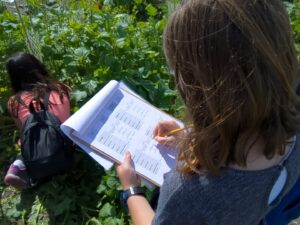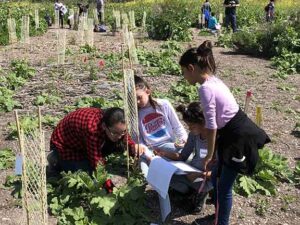Crystal Cove Student Data Included in First Scientific Journal Article!

Since 2016, fifth grade students from across Orange County have joined Crystal Cove Conservancy educators, UC Irvine scientists, and State Park land managers, helping us investigate how to best protect and preserve threatened open spaces like Crystal Cove State Park through the Project Crystal Community Science program. Last month, the findings from data collected by students were published for the first time in the scientific journal, Conservation Science and Practice, to be shared to the broader scientific community.
It can often be a challenge to ensure that native plants planted in restoration areas survive and thrive long term. Dr. Sarah Kimball at UC Irvine’s Center for Environmental Biology partnered with the State Park to test different methods for increasing the growth and survival of native species. Some of the experimental treatments tested including fencing plants to prevent herbivory, weeding non-natives from the surrounding area, and experimenting with how close seedlings should be planted to established adult shrub.
To determine the effectiveness of these strategies, fifth grade students were responsible for measuring the seedling’s growth and water use throughout the spring. From 2016-2018, over 1,000 fifth grade students came to Crystal Cove to help with the project. They came to Crystal Cove to learn about the ecological study at the beginning of the year, then returned to school to develop a hypothesis and train on data collection protocols. In the spring, students came back to Crystal Cove to collect data in the field, and then analyzed that data back in the classroom to determine the best restoration strategies to use in Moro Canyon.
 The data collected by students was shared directly with Dr. Kimball, and with State Parks resource managers, helping them make decisions about the best ways to restore native habitats in the park. To ensure the data student collected data was accurate, the Center for Environmental Biology compared the student data to data collected by professional ecologists and found them to be indistinguishable.
The data collected by students was shared directly with Dr. Kimball, and with State Parks resource managers, helping them make decisions about the best ways to restore native habitats in the park. To ensure the data student collected data was accurate, the Center for Environmental Biology compared the student data to data collected by professional ecologists and found them to be indistinguishable.
After being analyzed by Dr. Kimball, the findings were published this October in the open source scientific journal Conservation Science and Practice. The results of the study have provided practical recommendations that can now be used by not only Crystal Cove State Park, but also any resource manager looking to restore coastal sage scrub in Southern California. This is also the first time that student data from Crystal Cove Conservancy’s programs has been included in a published academic journal article, allowing our students to contribute directly to scientific research at Crystal Cove State Park.
To learn more about the project the results of the study, you can read the paper online here.
Since the completion of the original study described in Dr. Kimball’s paper, this year’s fifth grade students continue to investigate other restoration strategies in Moro Canyon. If you’re interested in learning more about the study and helping us prepare the restoration site for the new school year, join us at Field Science Saturday on December 14th. Find more info and RSVP here.
